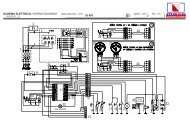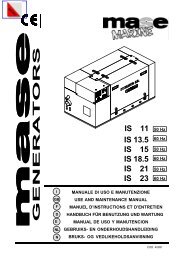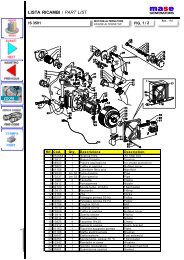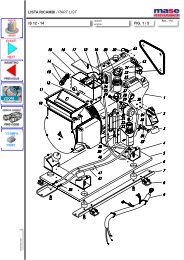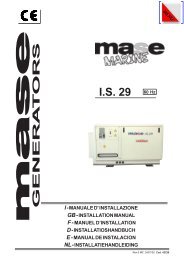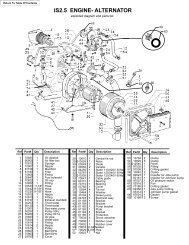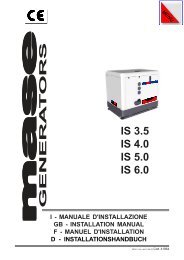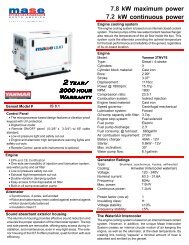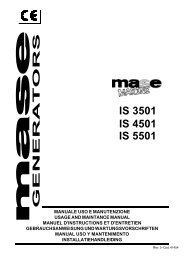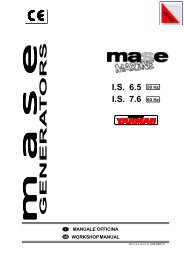41884. Installazione IS 12-14-16-19.p65 - Mase Generators of North ...
41884. Installazione IS 12-14-16-19.p65 - Mase Generators of North ...
41884. Installazione IS 12-14-16-19.p65 - Mase Generators of North ...
- No tags were found...
Create successful ePaper yourself
Turn your PDF publications into a flip-book with our unique Google optimized e-Paper software.
GENERATORSGB<strong>IS</strong> <strong>12</strong>-<strong>14</strong>-<strong>16</strong>-194.5 ComponentsThe sea water intake system mustbe separate from the one for the engines propellingthe boat.1 - Direct sea intake 1/2"If the unit is installed more than 1metre above the water-line, a check valve should befitted after the sea intake (fig.10, ref. 1) to prevent thewater circuit emptying when the motor is <strong>of</strong>f. If thisempties, the rotor <strong>of</strong> the water pump might be damagedduring start up; for the same reason, when the unit isfirst started up, the suction tube from the valve to thepump should be filled manually.2 - Ball tap (general) 1/2"3 - Ball tap (drainage) 1/2"This is used to drain the cooling system <strong>of</strong> theelectric generator for general maintenance or when along period <strong>of</strong> inactivity is expected.4 - Water filter (can be inspected)This must provide efficient protection for the coolingcircuit from the entrance <strong>of</strong> mud, sand and seaweed.Rate <strong>of</strong> flow <strong>IS</strong> <strong>12</strong>-<strong>16</strong>/19-19: 25/28 L/min.The filter mesh should be very fine.Mesh 2 - 470 micron is recommended, other sizes donot give good filter performance.5 - Anti-siphon valve: this is a valve that brings thecooling circuit back to atmospheric pressure whenthe motor is turned <strong>of</strong>f, thus avoiding the formation <strong>of</strong>siphons. It’s use obligatory when the base <strong>of</strong> thegenerator group is under the water line, and itmust be positioned at least 50 cm. above sea level.(see fig.5,7,9).Anti-siphon valve must be insertedbetween the inlet <strong>of</strong> the sea water pump and mixingelbow as indicated in Fig.13.The drainage duct <strong>of</strong> the anti-siphon valve must runbeneath the valve itself in order to prevent wateraccumulating in the duct, which should always remainempty to allow air to pass through when the unitis switched <strong>of</strong>f. (see fig.11)4.6 Drainage systemThe flue gas/water drainage system <strong>of</strong> the generatormust be separate from that <strong>of</strong> the main motorsThe length <strong>of</strong> the tube from thehighest point <strong>of</strong> the drain duct to the muffler shouldnot exceed 2 metres. This is to prevent the water leftin the drainage duct returning to the motor afterfilling the tank muffler, when the unit is turned <strong>of</strong>f.1 - Muffler.This dampens the noise <strong>of</strong> the drainage and stops thewater flowing back towards the motor. The mufflershould be installed no less than 1 metre away fromthe generator and positioned at a height as perfig.4,5,6,7,8,9.2 - SilencerThis further reduces noise. It should be installed nomore than 1 metre from the sea drainage nozzle.3 - Outboard drainage pipe.This must be fitted in a position that is constantlyabove sea level in all the vessel’s possible conditions<strong>of</strong> use.5 FUEL CIRCUITThe unit is fed by diesel fuel through the tubes marked“Fuel inlet”(fig.<strong>14</strong> ref.2 ) and “fuel outlet” (fig.<strong>14</strong> ref.3).This latter is used for the return <strong>of</strong> the excess fuel. Thereis no need for filters in connections to the fuel tank, sincethe unit already contains a fuel filter; however it isadvisable to fit a tap onto the fuel supply line downstream<strong>of</strong> the tank and a single-acting valve (check valve) toprevent the fuel system emptying for any reason. Use avalve with a 50 millibar opening. (Max head 0.8 mt.)The fuel pipes should be in hydrocarbon-resistant rubber,<strong>of</strong> inner diameter 8 mm.For further information, read theengine instruction manual, supplied by the enginemanufacturer.It is recommended that the drainage pipe from the antisiphonvalve be fed into the bilge, as small amounts <strong>of</strong>water might be drained through it during normal operation.The cooling circuit is connected to the heat exchangerpipe fitting as shown in Figure <strong>12</strong>.- 19 -



